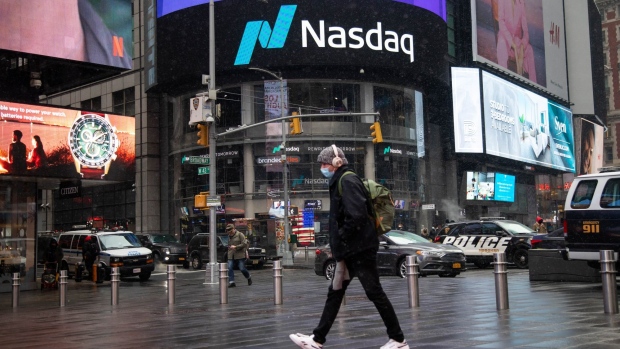Jan 29, 2022
NYC and Boston Brace For Heavy Snow as Bomb Cyclone Strikes
, Bloomberg News

(Bloomberg) -- The Northeast’s strongest storm yet this winter reached New York City Friday night, capping a day in which airlines canceled flights, cities readied their plows and officials urged residents to ride out the snow and high winds at home.
The storm was expected to drop 6 to 10 inches (15 to 25 centimeters) of snow on New York City, while raking the area with high winds that would intensify Saturday. Long Island could get as many as 18 inches, according to the National Weather Service, while Boston faced two feet of powder.
“Mother Nature has a tendency to do what she wants, and we’re just going to be prepared,” New York City Mayor Eric Adams said at an afternoon press conference. The city’s sanitation department planned to deploy 1,800 plows to keep streets passable as the storm descended, but residents were urged to stay off the roads.
“If you have to go out, you will be able to drive in New York City -- I strongly recommend you don’t,” said Edward Grayson, commissioner of the sanitation department.
In Boston, the storm prompted Mayor Michelle Wu to declare a snow emergency and open 24-hour shelters.
But the weather system was already causing disruptions well before it struck the region. More than 4,750 flights were canceled around the U.S. from Friday through Sunday, with the majority out of Boston, New York, Newark, New Jersey and Washington, according to FlightAware, an airline tracking service. Delta Air Lines Inc. canceled 1,290 flights through Sunday due to the severity of snow and winds, the company said in a statement.
New Jersey declared a state of emergency starting at 5 p.m. Friday in preparation for what Governor Phil Murphy called “a significant statewide snow event.” New York State followed suit at 8 p.m.
“Our advice to everyone is to be prepared to hunker down once you get home this afternoon and stay home,” Murphy said in a Friday briefing. “Stay home tonight and stay home tomorrow.”
The nor’easter was expected to rapidly intensify, with its central pressure dropping at least 24 millibars in 24 hours, a process called bombogenesis that forecasters dub “bomb cyclone.”
The resulting storm was expected to bring not just heavy snow but potent winds. New York City could see gusts as high as 35 miles (56 kilometers) per hour starting Saturday and rising to 50 mph as the storm pulls away, said James Tomasini, a weather service meteorologist in Upton, New York. With temperatures expected to plummet to about 12 degrees Fahrenheit (-11 degrees Celsius) late Saturday, the wind will make it feel closer to -5 degrees or colder.
“For the city, we’re expecting near-blizzard conditions,” Tomasini said.
Blizzard warnings stretched from Virginia to Maine, including the Delmarva Peninsula and Boston. It was Boston’s first blizzard warning since March 2018, said Rob Carolan, owner of Hometown Forecast Services. Widespread power outages are possible, with wind gusts near hurricane-strength of 74 mph.
“We are very easily going to gust over hurricane force on Cape Cod,” Carolan said. “It definitely looks like it is going to be a doozie.”
Winter storm warnings also extended into Canada’s Maritime provinces of Nova Scotia, New Brunswick, and Prince Edward Island, as well as parts of Newfoundland and Labrador, according to Environment and Climate Change Canada. As much as 40 centimeters of snow could fall in Halifax, with winds gusting to 100 kilometers per hour through Sunday.
Power Alerts
PJM Interconnection, the largest U.S. power grid operator, told generators to ensure they had sufficient fuel supplies and asked them and transmission companies to cancel maintenance plans across the southern and Mid-Atlantic region.
Electricity prices climbed Friday as the storm approached. New England spot power jumped 35% to an average $234 per megawatt-hour as of 3:20 p.m., while New York City rose 30% to average $227 after briefly topping $600. Earlier, prices in Maryland and Delaware soared to more than $1,500, according to PJM.
Temperatures will stay below freezing across much of the Northeast until at least Tuesday, meaning not a lot of snow will melt for a few days, U.S. Weather Prediction Center’s Marc Chenard said.
©2022 Bloomberg L.P.


